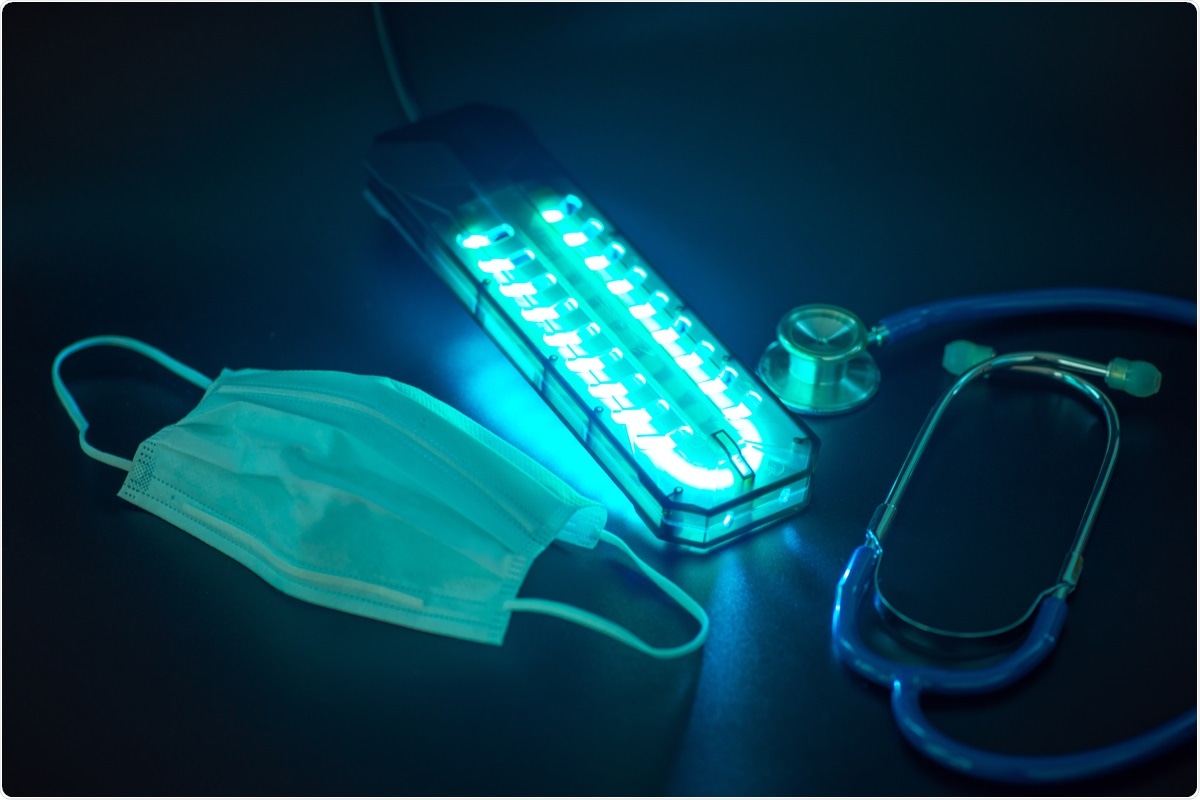Severe acute respiratory syndrome coronavirus 2 (SARS-CoV-2) spread across the world rapidly after emerging in Wuhan, China. Rapid transmission rates, asymptomatic infections, and high mortality rates within at-risk groups forced most countries to resort to closing public places, mandating face masks, and even stay-at-home orders and lockdowns.
 Study: Visible blue light inhibits infection and replication of SARS-CoV-2 at doses that are well-tolerated by human respiratory tissue. Image Credit: Nor Gal/ Shutterstock
Study: Visible blue light inhibits infection and replication of SARS-CoV-2 at doses that are well-tolerated by human respiratory tissue. Image Credit: Nor Gal/ Shutterstock
While mass vaccination programs have begun to halt the spread of the virus, they have stalled in several major countries. The rise of worrying variants of concern ensures that new tools against the disease are still essential. In a paper published in Scientific Reports, researchers from EMIT bio have developed a biological light unit (BLU) that can sterilize surfaces, killing SARS-CoV-2.
Background
Ultraviolet (UV) light is effective at killing microorganisms. It is often used as a sterilizing tool in hospitals. Many studies have shown the effectiveness of UV light, mostly UVC light, at inactivating coronaviruses that have not invaded cells while on surfaces aerosolized or within a liquid. When the RNA within the virus absorbs UVC photons, pyrimidine dimers form, preventing any further replication.
However, UVC light can also cause damage to mammalian genomes, risking mutations and lesions, limiting the use of UVC as a therapy. Photobiomodulation (PBM), also called light therapy, uses light in the visible spectrum or near-infrared to inactivate RNA and DNA viruses. The lack of an effective illumination platform has so far kept this from being used for effective therapy.
The study
The BLU the researchers developed can deliver safe wavelengths of visible blue light at selectable densities to inactivate SARS-CoV-2, whether it is inside a cell or not. The BLUs contain optimized LED arrays with narrow emission profiles. These arrays can illuminate assay plates with chosen doses of light repeatably and reliably. Each LED array is characterized by measuring the spectral flux relative to the wavelength. They found that 405nm LEDs show 16.5% of flux within the UVA spectrum, while 425nm wavelengths of light are nearly completely within the visible light spectrum.
To determine the applicability of this technology in human subjects, the researchers evaluated the effect of the BLUs on 3D tissue models developed from cells isolated from a single donor. Cells were taken from the bronchial/tracheal region to model how this technology could be realistically applied. The models created from these cells are 3-4 layers thick, including a mucociliary epithelium layer with a ciliated apical surface. These were exposed to 385nm, 405nm, and 425nm light over time. Unsurprisingly, the exposure to 385nm light, mostly UVA, showed a strong decrease in viability, over 50% in total. 405nm elicited a drop of 25%, while 425 nm showed little ability to damage the tissue, with only the strongest doses showing significant loss of viability.
To further investigate the effect of BLU arrays, the researchers examined the effect of 425nm blue light on Vero E6 cells, often used for evaluating cytotoxic properties of potential agents against SARS-CoV-2. At densities of 1x104 and 2x104, 425nm blue light resulted in 25-50% decreases in viability by 24 hours post illumination. At 4x104, the cells tolerated the light much better unless plated on a 48 well plate.
Following this, the impact of 425nm light on Vero E6 cells infected with SARS-CoV-2 was assessed using the same method. Even low doses of 425nm light were sufficient to reduce the viral load, with higher doses (albeit ones that have only small effects on the viability of uninfected cells) showing up to a 99.9% reduction in infection.
The scientists also observed if the irradiation time post-infection affected the results, but the log reduction in infection remained consistent. Similar results were seen in betacoronaviruses, including severe acute respiratory syndrome coronavirus 1 (SARS-CoV-1) and Middle East respiratory syndrome coronavirus (MERS)., although MERS did require higher doses of light for inactivation.
Conclusion
The researchers highlight that these BLUs were developed specifically to help create countermeasures against SARS-CoV-2 and the ability of the arrays to inhibit both cell-free and cell-associated SARS-CoV-2 infection. The results were equivalent across two independent laboratories, which shows the consistency and reliability of this new technology. With vaccination rates stalling in both the United Kingdom and the United States, and more variants emerging that can evade immunity and spread even more rapidly than the wild-type strain, this technology could be very useful in helping to end the global pandemic.